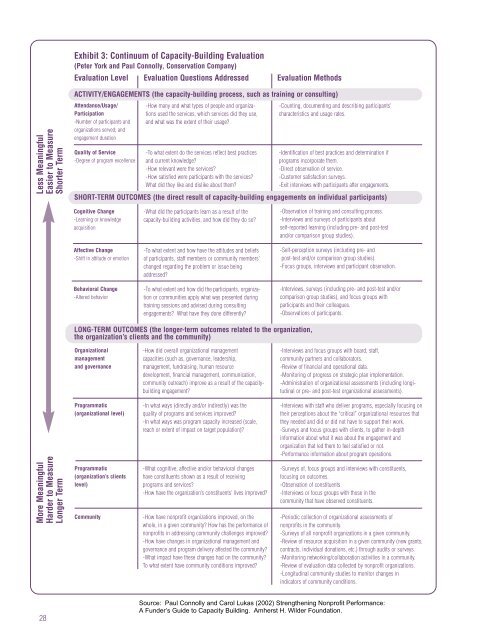Lessons from the Field - Seer Consulting
Lessons from the Field - Seer Consulting
Lessons from the Field - Seer Consulting
Create successful ePaper yourself
Turn your PDF publications into a flip-book with our unique Google optimized e-Paper software.
Less Meaningful<br />
Easier to Measure<br />
Shorter Term<br />
More Meaningful<br />
Harder to Measure<br />
Longer Term<br />
28<br />
Exhibit 3: Continuum of Capacity-Building Evaluation<br />
(Peter York and Paul Connolly, Conservation Company)<br />
Evaluation Level Evaluation Questions Addressed Evaluation Methods<br />
ACTIVITY/ENGAGEMENTS (<strong>the</strong> capacity-building process, such as training or consulting)<br />
Attendance/Usage/<br />
Participation<br />
-Number of participants and<br />
organizations served; and<br />
engagement duration<br />
Quality of Service<br />
-Degree of program excellence<br />
SHORT-TERM OUTCOMES (<strong>the</strong> direct result of capacity-building engagements on individual participants)<br />
Cognitive Change<br />
-Learning or knowledge<br />
acquisition<br />
Affective Change<br />
-Shift in attitude or emotion<br />
Behavioral Change<br />
-Altered behavior<br />
-How many and what types of people and organizations<br />
used <strong>the</strong> services, which services did <strong>the</strong>y use,<br />
and what was <strong>the</strong> extent of <strong>the</strong>ir usage?<br />
-To what extent do <strong>the</strong> services reflect best practices<br />
and current knowledge?<br />
-How relevant were <strong>the</strong> services?<br />
-How satisfied were participants with <strong>the</strong> services?<br />
What did <strong>the</strong>y like and dislike about <strong>the</strong>m?<br />
LONG-TERM OUTCOMES (<strong>the</strong> longer-term outcomes related to <strong>the</strong> organization,<br />
<strong>the</strong> organization’s clients and <strong>the</strong> community)<br />
Organizational<br />
management<br />
and governance<br />
Programmatic<br />
(organizational level)<br />
Programmatic<br />
(organization’s clients<br />
level)<br />
Community<br />
-What did <strong>the</strong> participants learn as a result of <strong>the</strong><br />
capacity-building activities, and how did <strong>the</strong>y do so?<br />
-To what extent and how have <strong>the</strong> attitudes and beliefs<br />
of participants, staff members or community members’<br />
changed regarding <strong>the</strong> problem or issue being<br />
addressed?<br />
-To what extent and how did <strong>the</strong> participants, organization<br />
or communities apply what was presented during<br />
training sessions and advised during consulting<br />
engagements? What have <strong>the</strong>y done differently?<br />
-How did overall organizational management<br />
capacities (such as, governance, leadership,<br />
management, fundraising, human resource<br />
development, financial management, communication,<br />
community outreach) improve as a result of <strong>the</strong> capacitybuilding<br />
engagement?<br />
-In what ways (directly and/or indirectly) was <strong>the</strong><br />
quality of programs and services improved?<br />
-In what ways was program capacity increased (scale,<br />
reach or extent of impact on target population)?<br />
-What cognitive, affective and/or behavioral changes<br />
have constituents shown as a result of receiving<br />
programs and services?<br />
-How have <strong>the</strong> organization’s constituents’ lives improved?<br />
-How have nonprofit organizations improved, on <strong>the</strong><br />
whole, in a given community? How has <strong>the</strong> performance of<br />
nonprofits in addressing community challenges improved?<br />
-How have changes in organizational management and<br />
governance and program delivery affected <strong>the</strong> community?<br />
-What impact have <strong>the</strong>se changes had on <strong>the</strong> community?<br />
To what extent have community conditions improved?<br />
-Counting, documenting and describing participants’<br />
characteristics and usage rates.<br />
-Identification of best practices and determination if<br />
programs incorporate <strong>the</strong>m.<br />
-Direct observation of service.<br />
-Customer satisfaction surveys.<br />
-Exit interviews with participants after engagements.<br />
-Observation of training and consulting process.<br />
-Interviews and surveys of participants about<br />
self-reported learning (including pre- and post-test<br />
and/or comparison group studies).<br />
-Self-perception surveys (including pre- and<br />
post-test and/or comparison group studies).<br />
-Focus groups, interviews and participant observation.<br />
-Interviews, surveys (including pre- and post-test and/or<br />
comparison group studies), and focus groups with<br />
participants and <strong>the</strong>ir colleagues.<br />
-Observations of participants.<br />
-Interviews and focus groups with board, staff,<br />
community partners and collaborators.<br />
-Review of financial and operational data.<br />
-Monitoring of progress on strategic plan implementation.<br />
-Administration of organizational assessments (including longitudinal<br />
or pre- and post-test organizational assessments).<br />
-Interviews with staff who deliver programs, especially focusing on<br />
<strong>the</strong>ir perceptions about <strong>the</strong> “critical” organizational resources that<br />
<strong>the</strong>y needed and did or did not have to support <strong>the</strong>ir work.<br />
-Surveys and focus groups with clients, to ga<strong>the</strong>r in-depth<br />
information about what it was about <strong>the</strong> engagement and<br />
organization that led <strong>the</strong>m to feel satisfied or not.<br />
-Performance information about program operations.<br />
-Surveys of, focus groups and interviews with constituents,<br />
focusing on outcomes.<br />
-Observation of constituents.<br />
-Interviews or focus groups with those in <strong>the</strong><br />
community that have observed constituents.<br />
-Periodic collection of organizational assessments of<br />
nonprofits in <strong>the</strong> community.<br />
-Surveys of all nonprofit organizations in a given community.<br />
-Review of resource acquisition in a given community (new grants,<br />
contracts, individual donations, etc.) through audits or surveys.<br />
-Monitoring networking/collaboration activities in a community.<br />
-Review of evaluation data collected by nonprofit organizations.<br />
-Longitudinal community studies to monitor changes in<br />
indicators of community conditions.


